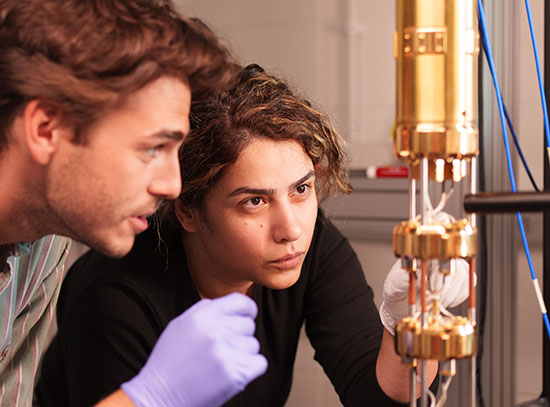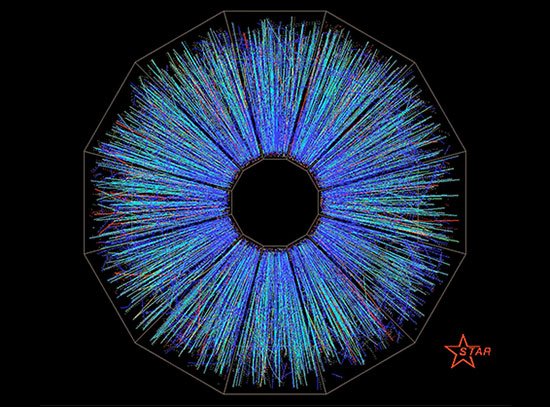Small, Shapeshifting Catalytic Nanoparticles Steer Carbon Dioxide Conversion
First-of-its-kind multimodal study reveals that smaller catalytic nanoparticles transform while converting carbon dioxide, unlike their larger counterparts
August 7, 2025
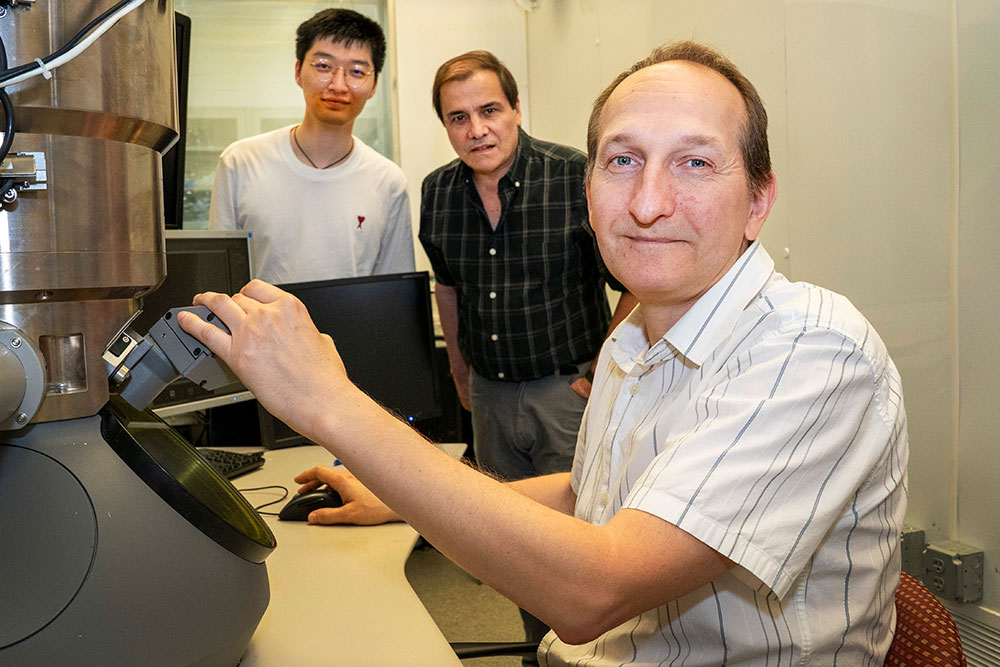 enlarge
enlarge
Brookhaven Lab researchers used the environmental transmission electron microscope at the Center for Functional Nanomaterials to observe the atomic-scale structure of catalytic nanoparticles. Their discovery — that the size of the catalytic nanoparticles determines how they transform during chemical reactions — will help guide the design of more effective catalysts for industrial applications. Brookhaven co-authors from left to right: Yuxi Wang, Jose Rodriguez, and Dmitri Zakharov. Not pictured: Kaixi Deng. (David Rahner/Brookhaven National Laboratory)
UPTON, N.Y. — Researchers from the U.S. Department of Energy’s (DOE) Brookhaven National Laboratory have discovered that the size of catalytic nanoparticles determines how their shape and structure transform during chemical reactions. With insights into the nanoparticles’ atomic-scale behavior as they convert carbon dioxide into useful fuel — and a better understanding of how structural changes impact catalytic performance — researchers are newly positioned to design more effective catalysts for industrial applications.
Catalysts are substances that speed up chemical reactions. Though they may temporarily shapeshift to accelerate chemical transformations, they are not permanently altered, enabling them to facilitate subsequent reactions. In a new multimodal study, recently published in the Journal of the American Chemical Society, Brookhaven researchers leveraged several powerful techniques to characterize a catalyst made up of cobalt oxide nanoparticles that sit atop a cerium oxide base. In contrast to commonly used catalyst ingredients, like platinum or palladium, cobalt and cerium are significantly more abundant and less expensive.
“We previously found that this cobalt-cerium oxide nanocatalyst system behaved differently when the cobalt-containing nanoparticles were smaller, but we didn’t know why,” said Kaixi Deng, first author on the paper who conducted this research at Brookhaven Lab while he was a graduate student at Stony Brook University. Deng is now a postdoctoral researcher at DOE’s Argonne National Laboratory.
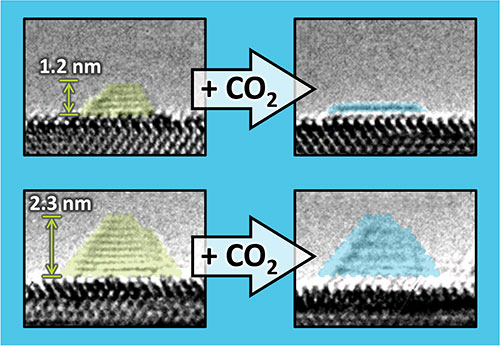 enlarge
enlarge
The above environmental transmission electron microscopy images show how the size of catalytic nanoparticles determines their shape and structure as they convert carbon dioxide into useful fuel. When cobalt oxide nanoparticles smaller than 2 nanometers are exposed to carbon dioxide gas, they rearrange from a 3D, pyramidal shape into a 2D, single layer of particles attached to the cerium oxide base. Larger cobalt oxide particles, on the other hand, maintain their 3D structure in the presence of carbon dioxide gas. (Brookhaven National Laboratory)
In some cases, the nanoparticles catalyzed the conversion of carbon dioxide to carbon monoxide. Other times, the reaction yielded methane — and sometimes the researchers observed a combination of both products.
“It’s important to control the morphology of the catalyst so reactions can yield the desired products, or ratio of products,” explained Jose Rodriguez, leader of the Catalysis: Reactivity and Structure group in Brookhaven’s Chemistry Division and co-lead author on the paper. “That’s how we optimize catalysts and make them more efficient for different applications.”
The research team expected the interface between cobalt and cerium oxide to play an important role in this behavior, and they used standard techniques in catalysis science, like in-situ X-ray absorption spectroscopy (XAS) and infrared spectroscopy, to start exploring this hypothesis.
“There was still an important part missing,” said Deng. “That’s why we wanted to take more direct measurements of this interface — ones that could show us what was happening during chemical reactions.”
A multimodal study
A typical electron microscope uses a beam of electrons to visualize nanoscale structures with much higher resolution than light-based microscopes. Electron microscopy experiments, however, are typically conducted in a vacuum because air molecules can interact with the electron beam and hinder the image quality.
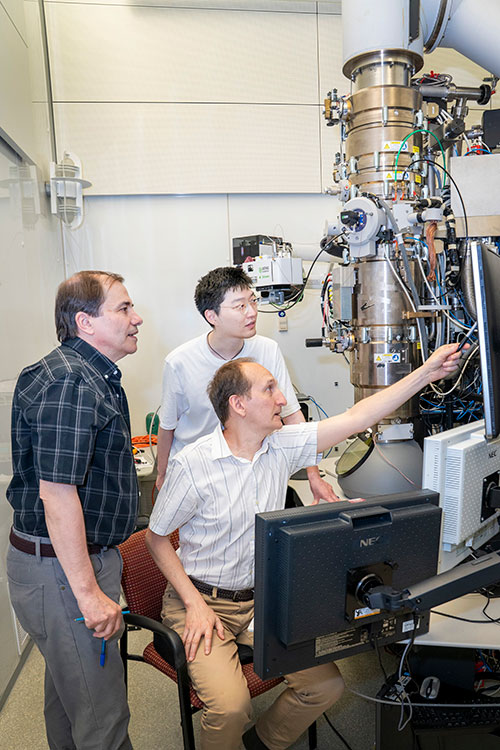 enlarge
enlarge
Unlike traditional electron microscopes, an environmental transmission electron microscope (E-TEM), pictured above, can accommodate gas in the sample area. Brookhaven researchers Jose Rodriguez, Yuxi Wang, and Dmitri Zakharov (clockwise from left) used the E-TEM to study how catalytic nanoparticles behave in the presence of carbon dioxide gas. Not pictured: Kaixi Deng. (David Rahner/Brookhaven National Laboratory)
The researchers wanted to observe the atomic-scale structure of the catalytic nanoparticles in the presence of carbon dioxide, so they needed a special type of electron microscope that could accommodate gas in the sample area.
“At the Center for Functional Nanomaterials (CFN), we use an environmental transmission electron microscope, or E-TEM, to study samples in gaseous environments and at high temperatures, similar to the working conditions catalysts experience during chemical reactions,” said Dmitri Zakharov, co-lead author on the paper and scientist at CFN, a DOE Office of Science user facility at Brookhaven Lab.
“The E-TEM is not a mainstream tool,” Zakharov added. “It’s only available at a few facilities worldwide, and experiments are really challenging since the core microscope, gas delivery equipment, sample holder, image acquisition system, and sample all have to ‘perform’ at the same time. The effort, however, is well worth it!”
The E-TEM studies revealed that when cobalt oxide nanoparticles smaller than 2 nanometers are exposed to carbon dioxide gas, they rearrange from a 3D, pyramidal shape into a 2D, single layer of particles attached to the cerium oxide base. Upon removal of the carbon dioxide gas, the nanoparticles returned to their pyramidal shape.
“The beauty of this whole dynamic system is that the nanoparticles want to bind carbon dioxide, so they rearrange in such a way that creates more sites for carbon dioxide to bind, increasing catalytic activity,” said Rodriguez. “We never imagined we would find something like this.”
If the particles were larger by even one nanometer — that’s just one billionth of a meter — they exhibited an entirely different behavior and maintained their 3D structure despite the introduction of carbon dioxide. This varying nanoparticle behavior explains, in part, why the conversion of carbon dioxide can yield different products or combinations of products: Carbon dioxide interacts with the catalytic nanoparticles in different ways, depending on the nanoparticle size and configuration.
“The E-TEM really made it possible to directly visualize the physical changes during a chemical reaction,” said Deng. But to fully understand the catalytic nanoparticles — and be able to optimize future catalysts — the researchers also needed to unveil the chemical behavior of the nanoparticles as they catalyzed reactions. So, the team turned to colleagues at the National Synchrotron Light Source II (NSLS-II), another DOE Office of Science user facility at Brookhaven Lab.
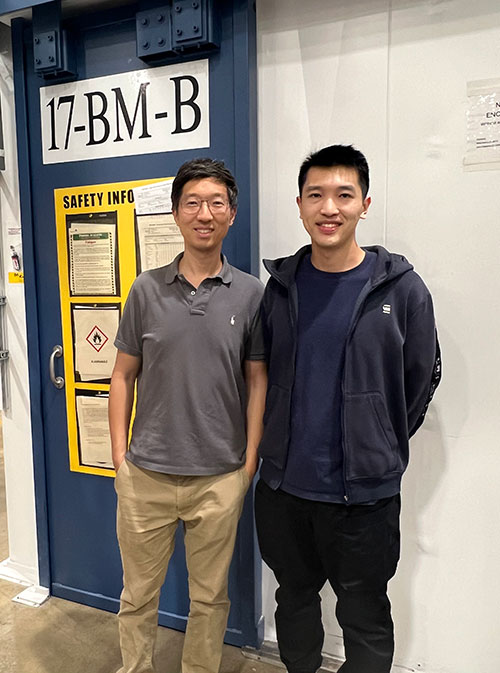 enlarge
enlarge
Wenqian Xu (left) and Kaixi Deng (right) conducted in situ X-ray diffraction studies at the Advanced Photon Source's Rapid Acquisition Powder Diffraction beamline. (Kaixi Deng/Argonne National Laboratory)
At NSLS-II, the researchers leveraged the In situ and Operando Soft X-ray Spectroscopy (IOS) and the Inner-Shell Spectroscopy (ISS) beamlines, where they conducted X-ray photoelectron spectroscopy (XPS) and XAS, respectively. The XPS and XAS studies provided information about the chemical composition of the catalyst when it was exposed to different temperatures or gas pressures.
“It’s great that we have all these powerful characterization techniques right here at Brookhaven Lab,” said Zakharov. “I can see both NSLS-II and the chemistry building from CFN. Leveraging such a breadth of tools and expertise all at one lab is hugely beneficial for collaborative, multimodal studies like this one.”
The Brookhaven researchers also collaborated with Wenqian Xu at the Advanced Photon Source (APS), a DOE Office of Science user facility at Argonne, to conduct in situ X-ray diffraction (XRD) at APS’s Rapid Acquisition Powder Diffraction beamline. The XRD studies offered insights into the catalyst’s overall crystalline structure, in contrast to the E-TEM experiments that were focused on local, microscopic structure.
As this was the first multimodal study to characterize the cobalt-cerium oxide nanocatalyst system while it converted carbon dioxide, theorists are eager to use the findings to build better models of catalysts. Such theoretical models could help discern why nanoparticles spread out on the cerium surface — and why their size determines their behavior.
Researchers who specialize in catalyst preparation plan to leverage the findings to guide the development of future catalysts. In some cases, they may desire increased methane production. So, they can modify catalyst synthesis techniques to ensure that the nanoparticles are small enough to flatten against the cerium base. For other industrial applications, they may prepare the catalyst differently to increase the likelihood of different reaction products, like carbon monoxide.
“This is just one step in understanding the system, but it’s an essential step,” said Rodriguez. “These findings, especially the E-TEM images, will serve as the new guiding direction for researchers working to figure out how this type of catalyst works.”
This work was supported by the DOE Office of Science. The samples used in this research were prepared by collaborators at the Institute of Catalysis and Petrochemistry in Madrid, Spain.
Brookhaven National Laboratory is supported by the Office of Science of the U.S. Department of Energy. The Office of Science is the single largest supporter of basic research in the physical sciences in the United States and is working to address some of the most pressing challenges of our time. For more information, visit science.energy.gov.
Follow @BrookhavenLab on social media. Find us on Instagram, LinkedIn, X, and Facebook.
2025-22531 | INT/EXT | Newsroom




